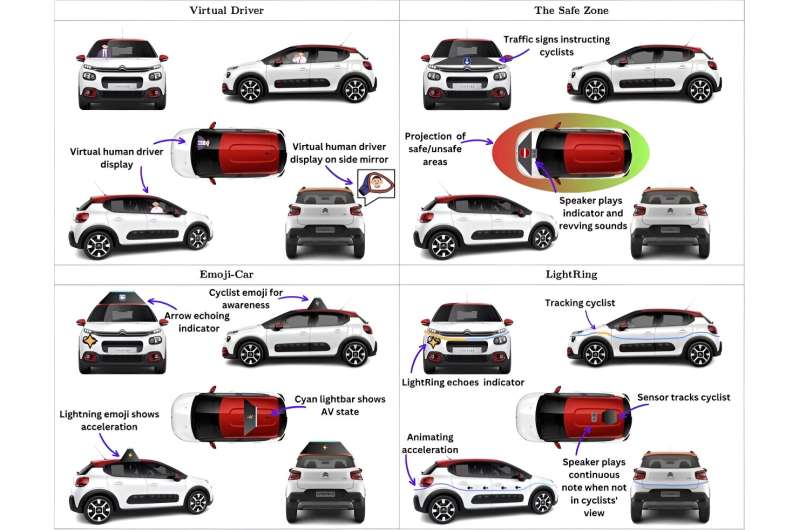This article has been reviewed according to Science X's editorial process and policies. Editors have highlighted the following attributes while ensuring the content's credibility:
fact-checked
trusted source
proofread
Digital displays on the exteriors of self-driving cars could help cyclists stay safe in the future

Digital displays on the exteriors of self-driving cars could help cyclists stay safe on the roads of the future, researchers say.
Animated representations of virtual drivers, traffic-light-like projections on to the road or even emojis displayed on their surfaces could allow autonomous vehicles to share advance warning of their movements with bike riders.
The recommendations are based on findings from new research from human-computer interaction researchers and psychologists at the University of Glasgow.
Together, they are exploring ways to replace the complex non-verbal language currently shared between drivers and cyclists once cars begin driving themselves.
Previous research from the same team, which was published as a paper in April, suggested that future generations of self-driving cars should "learn the language of cyclists" to help them safely share the roads with bikes.
Their new research, set to be presented as a paper titled "Pimp My Ride: Designing Versatile eHMIs for Cyclists" at the AutoUI '23 conference in Ingolstadt, Germany, next month, goes one step further.
The paper outlines the outcomes of workshops with cyclists which investigated how that language should be designed, displayed and interpreted to help reduce the risk of collisions between cars and bikes.
Professor Stephen Brewster, of the University of Glasgow's School of Computing Science, led the research. He said, "There's an urgent need to develop clear and consistent ways for cyclists to interact with autonomous vehicles, which are set to be a common sight in the future.
"Over the years, drivers and cyclists have developed their own language of gestures and other non-verbal cues to help negotiate the roads safely. That language helps both parties decide who has right of way, for example, or signal an intention to merge lanes.
"Currently, self-driving cars lack the ability to communicate with cyclists with anything close to that level of detail or nuance, which could make cycling, scootering and wheeling much more dangerous unless we find a way to reproduce that dialog.
"External human-machine interfaces, or eHMIs, like digital displays on the outside of vehicles are one promising solution to that problem. However, research into what forms these should take has been lagging behind the other technological developments of autonomous vehicles. With this study, we set out to develop some ideas that could lead to a new language for eHMIs to enable communication between road users."
The researchers gathered 12 volunteers in a car park to consider how autonomous vehicles might communicate with cyclists in different traffic scenarios, with bikes placed anywhere around the car. The volunteers were encouraged to draw directly on the surfaces of the car to show where they might want to see displays with details of how the displays might work.
The researchers grouped the results of their consultations into four suggestions of new ways autonomous vehicles could communicate with cyclists, which they called "virtual driver," "the safe zone," "emoji-car" and "LightRing."
The virtual driver concept would embed displays in autonomous vehicles' windscreens, side windows and mirrors. Those displays would show cyclists a digital avatar of a human driver. The avatar would use their hands and head to gesture using the social cues that bike riders are currently accustomed to exchanging with real drivers without cyclists having to learn any new methods of communication.
In the safe zone concept, displays on autonomous vehicles' exteriors would display traffic signs to advise riders if the car was going to yield or proceed. The cars would also project colors onto the road around them, with green areas safe for cyclists to enter and red spaces where cyclists should avoid.
The emoji-car design would use a roof-mounted display of a similar size those found on taxis to display emoticons to communicate with cyclists. Left and right arrows would echo indicators on the car and lightning symbols would show intent to accelerate.
Finally, the LightRing would use a band of LEDs wrapped around the body of the car paired with a sensor on the vehicle's roof. The LightRing would use colors and animations to communicate with pedestrians as well as cyclists. The car could signal proximity awareness by displaying an amber patch that grows as people get closer. Intentions to change speed could be accompanied by strokes of light that get faster as the car speeds up and slow down in the opposite direction as it decelerates.
Ammar Al-Taie, also of the University of Glasgow's School of Computing Science, is a co-author of the paper. He added, "Our consultations helped us develop a useful taxonomy of eHMI features for cyclists that we hope can help inform the design of future communication features on autonomous vehicles.
"Each of these concepts has their own limitations—the virtual driver, for example, might be limited by poor visibility in bad weather, and the emoji-car's placement on a roof might demand more attention from riders than other proposals which display visual information in places on the car where cyclists more often look during rides.
"However, they all address the issues raised during the consultation phase. Our participants want autonomous vehicles to signal their awareness of cyclists, and to allow cyclists to continue the behaviors they've already learned in keeping safe on the roads. To do that, a unified design language which provides consistent messaging is key."
Professor Brewster added, "Our research on this is still ongoing, and we're keen to refine our ideas further in real world settings. We're currently working on experiments to test prototypes of these eHMI designs on the road with cyclists to determine their effectiveness, and we hope to publish those results in the months to come."





















